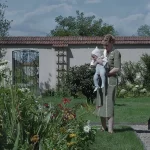Cunningham: Flat-Footed, by David Bax

Starting off with a bit of disclosure, I was unable to catch a 3D screening of Alla Kovgan’s Cunningham. Not that I’m exactly losing sleep over it. Despite my ongoing resolution not to turn into an old crank, I’ve never been a fan of the format, even when it’s Jean-Luc Godard directing the stereoscopic imagery. That said, one of the better uses of 3D in the last decade was Wim Wenders’ Pina, to which Cunningham bears a remarkable resemblance. Kovgan also seeks to replicate cinematically the work of a famous choreographer by allowing us to experiences its ups and downs, its ins and outs and its lefts and rights. Wenders succeeded by stripping away all that was unnecessary. Kovgan fails by throwing everything she can think of through the screen at us.
Kovgan mixes archival footage, old interviews and photos and, crucially, new stagings of her subject’s famous dances to tell the story of Merce Cunningham’s career. The Merce Cunningham Dance Company was a major force in avant garde dance for more than half a century but Cunningham focuses on its inception in the 1950s until the early 1970s, when the core group of dancers disbanded. Through collaborations with Robert Rauschenberg and John Cage (the latter of whom, along with Cunningham, provides some of the film’s best narration via interviews from the era), the company became an international sensation, at least among people who get excited about avant garde dance.
Kovgan does Cunningham a disservice by crowding his story and the power of his own creations with gratuitous whizbangery. Animated text, superimpositions, old pictures that slide onto the screen like some cheap iMovie effect; all of this is only a distraction from film’s chief draw.
Cunningham’s dances and the way Kovgan has restaged them for the camera are phenomenal. The flourishes used here are far more fruitful than the gimmicks listed above. A classic dolly-in/zoom-out on a dancer in a tunnel. Drone shots of figures prancing in unison on a rooftop. A soundstage filled with floating, silver, pillowy balloons that get brushed and kicked by the man and woman flitting through them (that one probably looked especially cool in 3D, I must admit). And through it all, the hypnotizing sounds of shuffling feet and rustling leotards. Even Kovgan’s one trick in these sequences–picture-in-picture comparisons between these new performances and vintage ones of the same dances–is pretty cool. 90 minutes of just this would have left me with nothing to complain about.
Instead, we get bizarre decisions like the early inclusion of an interview in which Cunningham insists that he wants his dances to stand on their own, not to “reflect” anything. Kovgan’s recreations fit that bill but so much of Cunningham‘s ancillary touches seem to openly defy the man. It’s possible to extract from that old interview that Cunningham probably would’ve hated the very idea of us analyzing him through his work. That doesn’t mean we shouldn’t do just that; as a critic, I advocate for it. But Kovgan wants to hold our hand through it when the dances could do most of the heavy lifting on their own.
With the specificity of her approach–3D, new dances but no new footage, etc.–Cunningham has the feel of a conceptual documentary. But Kovgan doesn’t seem sure of what the concept actually is.





























